Related Research Articles

War film is a film genre concerned with warfare, typically about naval, air, or land battles, with combat scenes central to the drama. It has been strongly associated with the 20th century. The fateful nature of battle scenes means that war films often end with them. Themes explored include combat, survival and escape, camaraderie between soldiers, sacrifice, the futility and inhumanity of battle, the effects of war on society, and the moral and human issues raised by war. War films are often categorized by their milieu, such as the Korean War; the most popular subjects are the Second World War and the American Civil War. The stories told may be fiction, historical drama, or biographical. Critics have noted similarities between the Western and the war film.
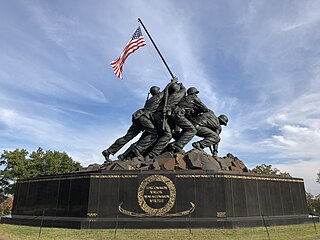
The United States Marine Corps War Memorial is a national memorial located in Arlington Ridge Park in Arlington County, Virginia. The memorial was dedicated in 1954 to all Marines who have given their lives in defense of the United States since 1775. It is located in Arlington Ridge Park within the George Washington Memorial Parkway, near the Ord-Weitzel Gate to Arlington National Cemetery and the Netherlands Carillon. The memorial was turned over to the National Park Service in 1955.
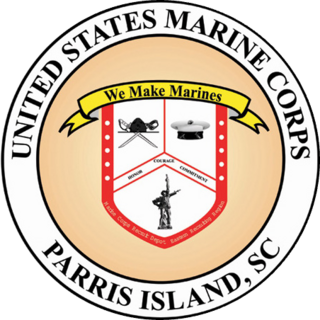
Marine Corps Recruit Depot Parris Island is an 8,095-acre (32.76 km2) military installation located within Port Royal, South Carolina, approximately 5 miles (8.0 km) south of Beaufort, the community that is typically associated with the installation. MCRD Parris Island is used for United States Marine Corps Recruit Training of enlisted United States Marines. Recruits living east of the Mississippi River report there to receive initial training. Recruits living west of the Mississippi River receive training at Marine Corps Recruit Depot San Diego, California, but may train at MCRD Parris Island by special request.

The Asiatic–Pacific Campaign Medal is a United States military award of the Second World War, which was awarded to any member of the United States Armed Forces who served in the Asiatic-Pacific Theater from 1941 to 1945. The medal was created on November 6, 1942, by Executive Order 9265 issued by President Franklin D. Roosevelt. The medal was designed by Thomas Hudson Jones; the reverse side was designed by Adolph Alexander Weinman which is the same design as used on the reverse of the American Campaign Medal and European-African-Middle Eastern Campaign Medal.
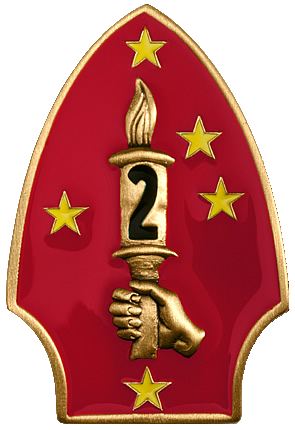
The 2nd Marine Division is a division of the United States Marine Corps, which forms the ground combat element of the II Marine Expeditionary Force. The division is based at Marine Corps Base Camp Lejeune, North Carolina and headquartered at Julian C. Smith Hall.

The 1st Marine Regiment is an infantry regiment of the United States Marine Corps based at Marine Corps Base Camp Pendleton, California. The regiment is under the command of the 1st Marine Division and the I Marine Expeditionary Force. The 1st Marine Regiment is also sometimes referred to as "Regimental Combat Team 1" or "Inchon".

Robert Hilliard Barrow was a United States Marine Corps four-star general. Barrow was the 27th Commandant of the Marine Corps from 1979 to 1983. He served for 41 years, including overseas command duty in World War II, the Korean War and the Vietnam War. Barrow was awarded the Navy Cross and Distinguished Service Cross for extraordinary heroism in Korea and Vietnam, respectively.

United States Marine Corps Women's Reserve (Reserve) was the World War II women's branch of the United States Marine Corps Reserve. It was authorized by the U.S. Congress and signed into law by President Franklin D. Roosevelt on 30 July 1942. Its purpose was to release officers and men for combat, and to replace them with women in U.S. shore stations for the duration of the war plus six months. Ruth Cheney Streeter was appointed the first director. The Reserve did not have an official nickname as did the other World War II women's military services.
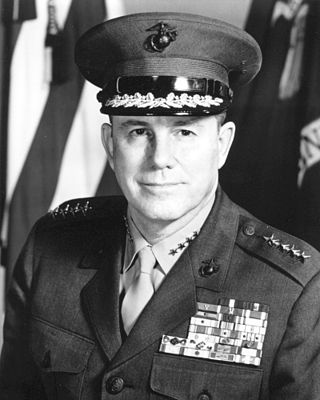
Robert Everton Cushman Jr. was a United States Marine Corps four-star general who served as the 25th commandant of the Marine Corps from January 1, 1972, to June 30, 1975. He was honored for heroism during World War II at the battles of Guam, Bougainville and Iwo Jima. He also commanded all Marine forces in the Vietnam War from June to December 1967, and served as deputy director of the Central Intelligence Agency (CIA) from 1969 to 1971.

David W. Sommers is a retired United States Marine who served as the 11th Sergeant Major of the Marine Corps from 1987 to 1991.

James Elms Swett was a United States Marine Corps fighter pilot and flying ace during World War II. He was awarded the United States' highest military decoration, the Medal of Honor, for actions while a division flight leader in VMF-221 over Guadalcanal on April 7, 1943. He downed a total of 15.5 enemy aircraft during the war, earning two Distinguished Flying Crosses and five Air Medals.

Air Force is a 1943 American World War II aviation film directed by Howard Hawks and starring John Garfield, John Ridgely, Gig Young, Arthur Kennedy, and Harry Carey. The film was distributed by Warner Bros. and produced by Hal B. Wallis and Jack L. Warner. Conceived by then - Lieutenant General “Hap” Arnold in the aftermath of the Pearl Harbor attack, it was originally scheduled for release on December 7, 1942, on the first anniversary. It became impossible to meet that deadline, and it premiered in New York City on February 3, 1943 and was released on March 20. The film's storyline revolves around an actual event that occurred on December 7, 1941. An aircrew ferries an unarmed 1940 series Boeing B-17D Flying Fortress heavy bomber, named the Mary-Ann, across the Pacific to the United States Army Air Forces base at Hickam Field. They fly right into the middle of the Japanese air attack on Pearl Harbor and the beginning of America's major involvement in the Second World War. An uncredited William Faulkner wrote the emotional deathbed scene for Ridgely, who played the commander and pilot of the Mary-Ann.
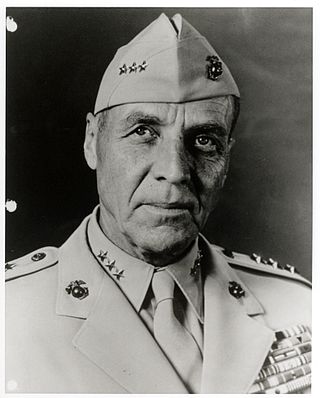
Lieutenant General Alan Shapley was a United States Marine Corps officer who survived the sinking of the USS Arizona during the World War II attack on Pearl Harbor, and went on to serve with distinction in the Pacific Theater and later in the Korean War. He was awarded the Silver Star for his gallantry on December 7, 1941, and later the Navy Cross for his extraordinary heroism during the Battle of Guam. His last command was as the commanding general of the Fleet Marine Force, Pacific.

The United States Marine Corps (USMC), also referred to as the United States Marines, is the maritime land force service branch of the United States Armed Forces responsible for conducting expeditionary and amphibious operations through combined arms, implementing its own infantry, artillery, aerial, and special operations forces. The U.S. Marine Corps is one of the eight uniformed services of the United States.

Beyond the Line of Duty is a 1942 American short propaganda film, directed by Lewis Seiler. The documentary film reenacted the life and career of United States Army Air Corps Captain Hewitt T. "Shorty" Wheless.

Louis Bentham Robertshaw was an American football player and lieutenant general in the United States Marine Corps. He flew combat missions in World War II and the Korean War and flew an F4B Phantom II fighter in the Vietnam War as commanding general of the 1st Marine Aircraft Wing. He received three Distinguished Flying Crosses, 12 Air Medals, the Navy Distinguished Service Medal, and three Legion of Merit with Combat "V."
United States Marine Band is a 1942 American short documentary film directed by Jean Negulesco, featuring the United States Marine Band. It was nominated for an Academy Award at the 15th Academy Awards for Best Short Subject (One-Reel).
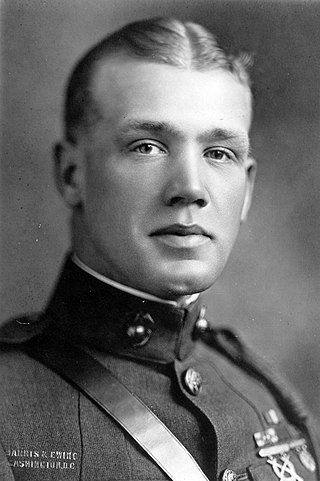
Harold Cyrus Roberts was a highly decorated officer in the United States Marine Corps with the rank of colonel. He was the recipient of three Navy Crosses, the United States military's second-highest decoration awarded for valor in combat.
The 11th Antiaircraft Artillery Battalion was a United States Marine Corps antiaircraft unit that served during World War II. Formed in 1942 as the 11th Defense Battalion, its original mission was to provide air and coastal defense for advanced naval bases. During the war the battalion defended took part in combat operations in the Solomon Islands. The battalion's tank platoon also saw extensive action on New Georgia and Arundel Island. The battalion was decommissioned before the end of the war on December 15, 1944.

The 51st Defense Battalion was an antiaircraft and coastal defense unit in the United States Marine Corps that served during World War II. The battalion was originally formed in August 1942 and was the first African American unit in the Marine Corps. Its original mission was to provide air and coastal defense for advanced naval bases. During the war the battalion served in the Ellice and Marshall Islands, in the Pacific Theater. The 51st returned to Marine Corps Base Camp Lejeune, North Carolina after the war and was decommissioned on January 31, 1946. To date, no other Marine Corps battalion has carried the lineage and honors of the 51st Defense Battalion.
References
- ↑ Happer, Hedda (December 24, 1942). "SCREEN". Los Angeles Times. Retrieved January 7, 2013.[ dead link ]
- ↑ Mastro, Frank (December 30, 1942). "Show Marines' Drill Program in New Picture". Chicago Daily Tribune. p. 21. Archived from the original on February 16, 2013. Retrieved January 7, 2013.
- ↑ "The 15th Academy Awards (1943) Nominees and Winners". oscars.org. Retrieved June 26, 2013.
- ↑ Hemenez, Richard L. (June 2001). The United States Marine Corps in books and the performing arts. McFarland. pp. 623–. ISBN 9780786407583 . Retrieved January 7, 2013.
This salute to the Corps musicians received a 1942 Academy Award nomination for Short Film (one reel) along with Marines in the Making...
- ↑ Polesie, Herbert (December 26, 1942), Marines in the Making (Documentary, Short), Pete Smith, R. E. 'Dick' Hanley, Charles Horvath, Loew's, retrieved June 17, 2024